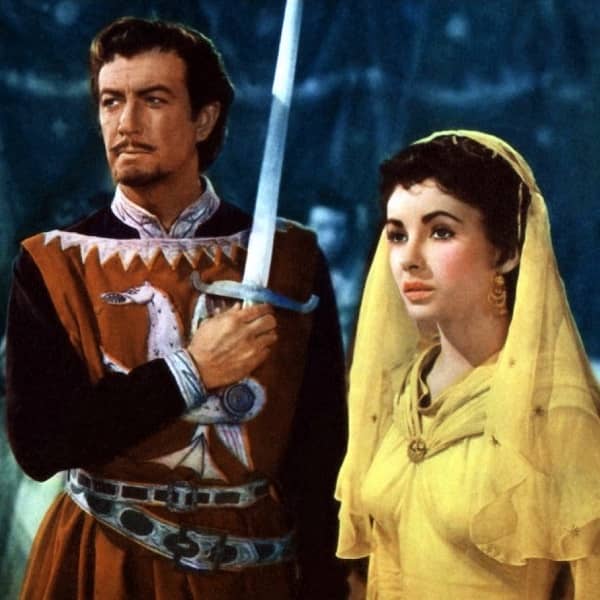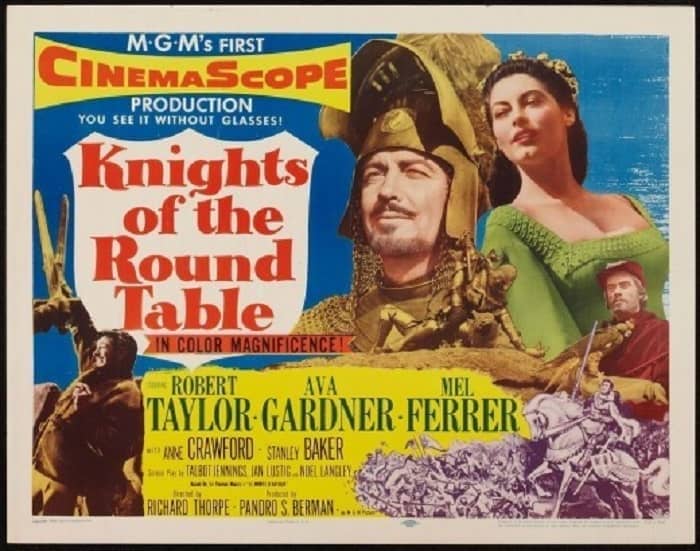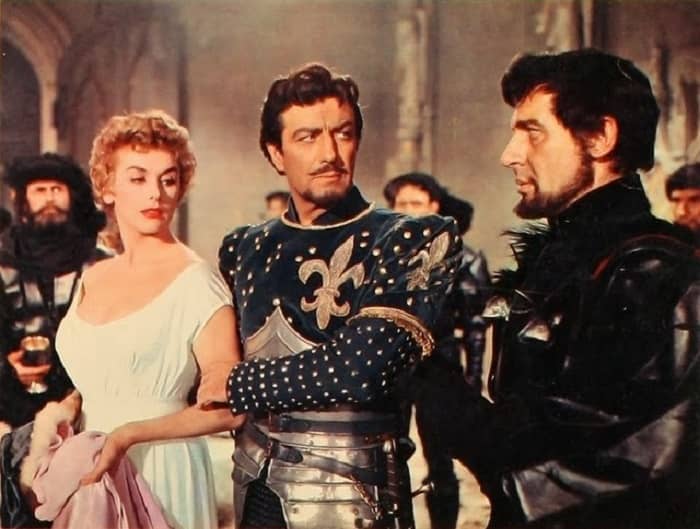Ellsworth’s Cinema of Swords: Days of Technicolor Knights
Hang on to your hauberks! This week we’re taking a gander at veteran director Richard Thorpe’s quasi-trilogy about knights in shining armor, three films all starring Robert Taylor that set the look and feel of screen stories about medieval knights for more than a decade.
Ivanhoe
Rating: ****
Origin: USA, 1952
Director: Richard Thorpe
Source: Amazon streaming video
In 1814 the poet Walter Scott began publishing his popular Waverly novels of recent Scottish history, and then switched, with Ivanhoe in 1820, to the medieval era and the history of England, in the process co-inventing (along with Jane Porter) the modern genre of the historical adventure novel. Ivanhoe was a landmark in other ways as well, for its sympathetic treatment of Jews in Western societies, for establishing the character and tone of our modern version of Robin Hood, and for promoting the medieval background as a setting for adventure tales, still as popular today in the 21st century as Scott made them in the 19th. (That’s right: no Ivanhoe, no Game of Thrones.)
This blockbuster 1952 MGM film was also something of a landmark: its success made movies of knights in shining armor a Hollywood staple for years to come, it brought Scott’s treatment of the plight of the Jews to the big screen, and it launched Elizabeth Taylor to the heights of stardom. Its titular hero, however, is another Taylor, Robert, in the role of Sir Wilfred of Ivanhoe, a knight in the service of King Richard the Lion-Hearted who has newly returned from the Crusades. King Richard has been imprisoned by Leopold of Austria, so Ivanhoe has vowed to raise the money for his ransom, and to fight for the Saxons against Prince John and Norman oppression while he’s at it. As if that weren’t enough, he also wants to marry the Lady Rowena (Joan Fontaine), but to do that he’ll have to regain the lost favor of his fierce Saxon father, Sir Cedric (Finlay Currie, with an amazing head of hair). To get anywhere on this impressive list of goals, Ivanhoe must first win the Big Tournament, but he can’t enter without money for horse and gear — which is how he meets Rebecca (Elizabeth Taylor), the daughter of a moneylender. Do sparks fly? Yes, they do.
Of course, a hero is only as good as his villains, and Ivanhoe has some dangerous foes in Prince John (the wolfish, sneering Guy Rolfe) and the foremost of the Norman knights, the arrogant Sir Bois-Guilbert — played by George Sanders, so now you know we’re in for a good time! The movie was filmed in and among the castles of Scotland, so the scenery is fabulous, and the castle interiors are properly cramped, stony, and asymmetrical. Some of the weapons are wrong for the period, but the knights’ armor is right, all suits and coifs of chainmail rather than the plate armor of later times. The film is bookended by two knightly tournament scenes, both classic in their way, but they’re outdone in the middle by the exciting siege and assault on a castle, as the Saxons, led by Robin Hood (Harold Warrender), finally rise against the Normans. If you’ve ever looked at a medieval castle and wondered how the devil attackers could get across a moat and up a sheer wall in the face of bolts and boulders, Ivanhoe shows you how.
The movie’s not without flaws: except for a few weak jokes from Wamba, Ivanhoe’s jester-turned-squire, it’s a humorless affair, and here and there it drags a bit. Robert Taylor looks the part but his acting is rather dry and stiff, and the same can be said of Joan Fontaine. Of the leads in the love triangle, only Elizabeth Taylor as Rebecca the Jewess really shines, almost literally; when she’s onscreen you can’t look away. And it’s not just because she’s stunning, she’s also far and away the best actor in the picture. Only Sanders comes close: after Bois-Guilbert loses his black villain’s heart at first sight of Rebecca, he’s conflicted at every turn and never sure of himself again. Kudos must also be paid to Felix Aylmer for his fine performance as the Jewish patriarch Isaac, and to Miklós Rósza for the rousing score, one of his best. A whole series of medieval movie epics will follow in the wake of Ivanhoe, but few will be as good.
Knights of the Round Table
Rating: ***
Origin: USA, 1953
Director: Richard Thorpe
Source: Amazon streaming video
Thomas Malory’s Le Morte d’Arthur (1485) was the first comprehensive collection of the legends of King Arthur and his Knights of the Round Table in English, and according to the opening credits of this film, Malory was the source material for the story — though considering the script, The Boy’s King Arthur by Sidney Lanier (1880) is a more likely candidate. This is producer Pandro Berman’s follow-up to the hugely successful Ivanhoe, with the same director, crew, male lead (Robert Taylor), and composer (Miklós Rózsa) — but this time the team barely puts it across. It’s harder to boil down a collection of tales into a coherent story than it is to adapt a novel, and Merlin, Guinevere, Arthur, and his knights are more archetypes than fleshed-out characters, two problems that this movie doesn’t successfully solve.
Let’s just get the failings of this flick out of the way so we can focus on what’s worth watching. First of all, the dialogue is atrocious, stilted Ye Olde Englishe, and the actors deliver it dead on arrival, as stiff as slabs of oak. The characters are all simple and shallow, allowed just about one note apiece (archetypes, remember?). The knights move awkwardly in their foolish Hollywood plate armor, and the knight-on-knight combats are reduced to painfully artless flailing that goes on way too long. And though the heart of the story is the Arthur-Guinevere-Lancelot love triangle, as it should be, Sir Percival’s quest for the Holy Grail is clumsily and intrusively shoe-horned into the narrative, possibly to give the film some moral cover in the staid 1950s, since otherwise it’s basically a tale of medieval adultery. Moreover, Percival stopping everything to have divine visions is disturbingly out-of-tone, as it’s the only supernatural aspect retained from Malory: Merlin here is just a wise old advisor, not a wizard, and Morgan le Fay uses poison rather than magic.
But this movie is still worth your time for two reasons. First, it succeeds as a visual spectacle. Based solely on looks, the casting is perfect: Taylor is proud, upright, and stern as Lancelot, Ava Gardner as Guinevere would make any knight forsake his vows, Mel Ferrer is earnest and leonine as King Arthur, Stanley Baker sneers convincingly as Modred, and Gabriel Woolf as Sir Percival looks like he stepped out of a Pre-Raphaelite painting. There are two large, pitched battles that are surprisingly effective — clearly director Richard Thorpe had studied his Eisenstein. And Thorpe’s composition and staging of scenes and individual shots is impeccable: sharp, painterly, and memorable.
Finally, as dumb as the script is — and it’s real dumb — the basic plot of the rise and fall of Camelot as embodied in the love triangle of the three principles is such a strong story that it works anyway, despite the crappy dialogue. There’s real emotion in this timeless tragedy, and Gardner and Taylor manage to wring it out by heroically underplaying their roles while everyone around them is hamming it up. Surprising, but there it is: go figure.
The Adventures of Quentin Durward (or Quentin Durward)
Rating: ***
Origin: USA / UK, 1955
Director: Richard Thorpe
Source: Warner Archive DVD
After Robert Taylor’s smash hit as a knight in Ivanhoe, and a follow-up in Knights of the Round Table, MGM dug up another Walter Scott potboiler in Quentin Durward to try for three. The result is mixed at best: the novel doesn’t adapt well to the Hollywood treatment, being slow to start and spending too much time on the politics of 15th-century France, the romance is obvious and perfunctory, with the talented comedian Kay Kendall miscast as an over-serious countess who never gets a funny line, plus the villain is a cartoon caricature, the depiction of the funny Gypsy sidekick is an ethnic abomination, the costumes, gear, and settings are rife with anachronism, and the dialogue is one sad cliché after another. But there are two important reasons to watch it anyway, especially the scene where… but wait. We’ll get to it.
Scottish knight Quentin Durward (Taylor) is summoned by his elderly uncle, who’s contemplating matrimony, and after a few unfunny Scots-are-stingy jokes Durward is sent to France to inspect the prospective bride, Countess Isabelle (Kendall) — and evaluate her dowry. She’s a ward of Charles the Bold, the Duke of Burgundy, who for a Scottish alliance is marrying her off against her will to Durward’s uncle. There follows an hour of court politics with brief interludes of action in which Durward displays his knightly courage. The Scottish knight is represented as a romantic but obsolete relic of chivalry, and in fact throughout the film all his plans rely solely on reckless bravery. How can Isabelle fail to fall for him?
Durward follows Isabelle from the court of Duke Charles to that of his rival, the nominal monarch of France, King Louis XI. And finally, we get to a place where the movie is worth the time invested, because the wily and shameless King Louis is played to perfection by Robert Morley, at the height of his wry, eyebrow-waggling powers. He’s just so good. Never one to miss an opportunity, the king co-opts the honest and simple Durward and employs him as a tool in a rather unlikely intrigue, assigning him as Isabelle’s bodyguard to protect Louis’s reputation, for Isabelle is to be abducted and forcibly married to La Marck, “the Beast of the Ardennes” (Duncan Lamont), that cartoon villain mentioned earlier. Durward, sadly, is to be slain defending Isabelle’s honor.
It doesn’t work out that way, of course. Away from the courts and kings, in its last third the movie kicks into gear at last, as La Marck’s black-clad goons erupt from ambush to pursue our knight and his countess. Taylor gets to do some very credible swashbuckling in a running fight at a country inn, and then successfully escorts the countess to the forest-girt castle of her archbishop uncle, where she will presumably be safe. But La Marck uses Louis’s gold to buy cannon, the walls are breached, and the foxes are in the henhouse. Which brings us to the other compelling reason to watch this flick, the absolutely insane final duel between Durward and La Marck, whacking at each other as they both desperately swing back and forth on bell-ropes high in the top of a burning cathedral belfry, the great bells tolling out above them. No, I’m serious! It’s glorious madness that’s not to be missed.
The previous installments in the Cinema of Swords are:
Olivia de Havilland — First Queen of the Swashbucklers
Goofballs in Harem Pants
Disney’s Early Swashbucklers
‘50s Vikings – Havoc in Horned Helms
Laughing Cavaliers
Charming and Dangerous: Douglas Fairbanks, Jr.
Eleven Samurai: Early Chambara Classics
Beyond Captain Blood: Three by Sabatini
3 Musketeers + 1 Long Nose
Louis Hayward, Everyman with a Sword (Part 1 of 2)
LAWRENCE ELLSWORTH is deep in his current mega-project, editing and translating new, contemporary English editions of all the works in Alexandre Dumas’s Musketeers Cycle, with the fourth volume, Blood Royal, just published by Pegasus Books in the US and UK. His website is Swashbucklingadventure.net.
Ellsworth’s secret identity is game designer LAWRENCE SCHICK, who’s been designing role-playing games since the 1970s. He now lives in Dublin, Ireland where he is co-designing a new mobile RPG for the WarDucks game studio.



I must say Ivanhoe and Excalibur can pretty much be credited for my longstanding interest in fantasy. Wasn’t aware they made a Quentin Durward movie! The novel I quite enjoyed, and of course anyone serious about reading some classic fantasy/medieval romance has to have read Ivanhoe. Pity they didn’t make a Talisman movie, or did they? Could still be a platform for a good epic.
I read Ivanhoe this year after tiptoeing around it for decades and loved every page of it; it’s an absolutely ripping yarn. The movie is fun (especially if you’re a hardcore George Sanders junkie) but doesn’t come up to the novel’s standard – no surprise there, I guess.
Thanks for another entry in your Cinema of Swords, Mr. Ellsworth! Always worth a look, you’ve chosen three good ones with the great Ivanhoe in lead. Ivanhoe has been a favorite since I was a kid when I first heard Robert Taylor singing
“My heart was a lion but now it is chained”. When I got older, I appreciated just how good (and how gorgeous) Liz Taylor was in this film; I’ve never seen a fair maiden on screen who beats her, although the great Kay Kendall comes close.
I prefer Quinten Durward to the KotRT because of her and that gonzo duel in the belfry. You have to see Kendall in a film like Les Girls to see her at her best though.
Thanks again!